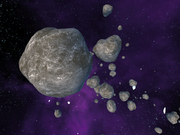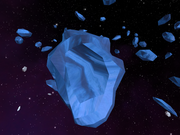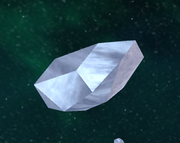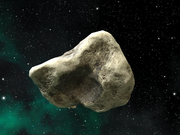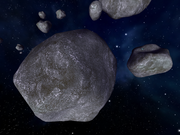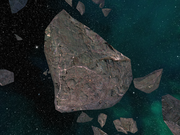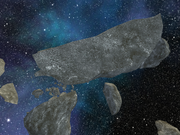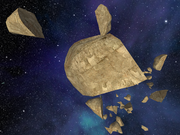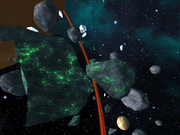Difference between revisions of "Mining"
MarkMcDoogle (Talk | contribs) m (→Types of Asteroids) |
MarkMcDoogle (Talk | contribs) m (→List of Ores) |
||
| Line 48: | Line 48: | ||
{| border="1" | {| border="1" | ||
|- | |- | ||
| − | ! width=" | + | ! width="135" colspan="2" | Ore Name |
! width="40" | EXP | ! width="40" | EXP | ||
! width="40" | Mass | ! width="40" | Mass | ||
| − | ! width=" | + | ! width="75" | Asteroid Type |
! width="300" | Description | ! width="300" | Description | ||
! width="100" | Rough Price/Unit | ! width="100" | Rough Price/Unit | ||
| Line 57: | Line 57: | ||
! colspan="7" | Common, found in almost every sector | ! colspan="7" | Common, found in almost every sector | ||
|- | |- | ||
| − | ! valign="top" width="45"| [[Image:Aquean_Ore.png]] | + | ! valign="top" width="45" | [[Image:Aquean_Ore.png]] |
! width="90" | Premium Aquean | ! width="90" | Premium Aquean | ||
| align="center" | 4pt | | align="center" | 4pt | ||
| align="center" | 70kg | | align="center" | 70kg | ||
| − | | align="center" | | + | | align="center" | 1, 2 |
| align="left" | Dirty ice, mostly H2O with trace chemicals. | | align="left" | Dirty ice, mostly H2O with trace chemicals. | ||
| align="center" | low | | align="center" | low | ||
| Line 69: | Line 69: | ||
| align="center" | 5pt | | align="center" | 5pt | ||
| align="center" | 150kg | | align="center" | 150kg | ||
| − | | align="center" | | + | | align="center" | 1,2,4,7 |
| align="left" | Unrefined silicate material. | | align="left" | Unrefined silicate material. | ||
| align="center" | 20cr - 70cr | | align="center" | 20cr - 70cr | ||
| Line 77: | Line 77: | ||
| align="center" | 5pt | | align="center" | 5pt | ||
| align="center" | 150kg | | align="center" | 150kg | ||
| − | | align="center" | | + | | align="center" | 3,4,5,6,7,8 |
| align="left" | Ore which is heavy in carbon compounds. | | align="left" | Ore which is heavy in carbon compounds. | ||
| align="center" | 30cr - 60cr | | align="center" | 30cr - 60cr | ||
| Line 85: | Line 85: | ||
| align="center" | 6pt | | align="center" | 6pt | ||
| align="center" | 200kg | | align="center" | 200kg | ||
| − | | align="center" | | + | | align="center" | 1,4,5,6,7,8 |
| align="left" | Ore composed mostly of iron. | | align="left" | Ore composed mostly of iron. | ||
| align="center" | 70cr - 200cr | | align="center" | 70cr - 200cr | ||
| Line 95: | Line 95: | ||
| align="center" | 7pt | | align="center" | 7pt | ||
| align="center" | 150kg | | align="center" | 150kg | ||
| − | | align="center" | | + | | align="center" | 1,2 |
| align="left" | A common asteroid composition containing lighter elements and chemical compounds. | | align="left" | A common asteroid composition containing lighter elements and chemical compounds. | ||
| align="center" | 100cr - 500cr | | align="center" | 100cr - 500cr | ||
| Line 103: | Line 103: | ||
| align="center" | 7pt | | align="center" | 7pt | ||
| align="center" | 250kg | | align="center" | 250kg | ||
| − | | align="center" | | + | | align="center" | 4,5,6,8 |
| align="left" | A common asteroid composition containing heavy and radioactive metals. | | align="left" | A common asteroid composition containing heavy and radioactive metals. | ||
| align="center" | 100cr - 400cr | | align="center" | 100cr - 400cr | ||
| Line 113: | Line 113: | ||
| align="center" | 8pt | | align="center" | 8pt | ||
| align="center" | 300kg | | align="center" | 300kg | ||
| − | | align="center" | | + | | align="center" | 8 |
| align="left" | Ore containing the precious mineral Xithricite | | align="left" | Ore containing the precious mineral Xithricite | ||
| align="center" | 200cr - 900cr | | align="center" | 200cr - 900cr | ||
| Line 121: | Line 121: | ||
| align="center" | 10pt | | align="center" | 10pt | ||
| align="center" | 200kg | | align="center" | 200kg | ||
| − | | align="center" | | + | | align="center" | 1,5 |
| align="left" | Ore containing heavy and radioactive metals. | | align="left" | Ore containing heavy and radioactive metals. | ||
| align="center" | 700cr - 1000cr | | align="center" | 700cr - 1000cr | ||
| Line 129: | Line 129: | ||
| align="center" | 15pt | | align="center" | 15pt | ||
| align="center" | 150kg | | align="center" | 150kg | ||
| − | | align="center" | | + | | align="center" | 2 |
| align="left" | Rare ore found often in young solar systems | | align="left" | Rare ore found often in young solar systems | ||
| align="center" | 300cr - 1800cr | | align="center" | 300cr - 1800cr | ||
| Line 139: | Line 139: | ||
| align="center" | 12pt | | align="center" | 12pt | ||
| align="center" | 250kg | | align="center" | 250kg | ||
| − | | align="center" | | + | | align="center" | 2,4 |
| align="left" | Rare ore formed in the residue of a star’s collapse | | align="left" | Rare ore formed in the residue of a star’s collapse | ||
| align="center" | 200cr - 1200cr | | align="center" | 200cr - 1200cr | ||
| Line 147: | Line 147: | ||
| align="center" | 14pt | | align="center" | 14pt | ||
| align="center" | 200kg | | align="center" | 200kg | ||
| − | | align="center" | | + | | align="center" | 5 |
| align="left" | A rare asteroid composition formed only at very high temperatures | | align="left" | A rare asteroid composition formed only at very high temperatures | ||
| align="center" | 500cr - 1500cr | | align="center" | 500cr - 1500cr | ||
| Line 155: | Line 155: | ||
| align="center" | 18pt | | align="center" | 18pt | ||
| align="center" | 150kg | | align="center" | 150kg | ||
| − | | align="center" | | + | | align="center" | 7 |
| align="left" | A rare asteroid composition of complex chemical material | | align="left" | A rare asteroid composition of complex chemical material | ||
| align="center" | 400cr - 2200cr | | align="center" | 400cr - 2200cr | ||
| Line 163: | Line 163: | ||
| align="center" | 20pt | | align="center" | 20pt | ||
| align="center" | 100kg | | align="center" | 100kg | ||
| − | | align="center" | | + | | align="center" | 3,4 |
| align="left" | Rare ore formed under intense heat and tidal forces | | align="left" | Rare ore formed under intense heat and tidal forces | ||
| align="center" | 400cr - 2400cr | | align="center" | 400cr - 2400cr | ||
|} | |} | ||
{{br}} | {{br}} | ||
| + | |||
===Asteroid Field Features=== | ===Asteroid Field Features=== | ||
[[image:Asteroid_Light-Dark_Round_Cluster.png|thumb|right|Cluster of roids]] | [[image:Asteroid_Light-Dark_Round_Cluster.png|thumb|right|Cluster of roids]] | ||
Revision as of 23:49, 17 June 2005
Contents
Overview
There is a mining tutorial available at mining stations. It will give you the basic equipment, tell you how to equip the equipment, scan, mine and give you a level 1 mining license. The level 1 license gives you acess to a large port (L-port) mining gun making it possible to mine in a Wraith with a scanner equipped. To find a mining station look next to the name of the station, There you should find a description of the type of station.
Mining involves grabbing a ship and a mining beam and extracting valuable ores from asteroids.
You generally use a scanner to identify which ores are in asteroids, get <100m away from the asteroid, and then fire a beam to start mining. When you mine the lower-level ores, you get 'premium' versions of that ore, as opposed to the regular version of the ore that is sold at stations.
The more you mine an asteroid, the hotter it gets. The hotter an asteroid gets, the slower it mines. All asteroids start at 10 degrees Kelvin. Efficiency drops off significantly after 20 or 30 Kelvin. Some miners can go to 200 or 400 Kelvin in certain circumstances and still feel that it was worth it for the profit. After you stop mining, the asteroid cools. Small asteroids heat and cool more quickly than large ones.
As you gain mining licenses, you will have access to better mining beams. Some beams will extract ores with a higher probability, which translates into higher efficiency in terms of time, heat, and money.
As you gain experience, you will learn which ores are valuable, where to find them, and where to sell them. You might even get involved with group mining, involving escorts, scouts, and transports.
Resources
List of Mining Scanners
There are only 2 scanners right now.
The Mineral Scanner has a range of 500m, and will activate whenever you 'target' an asteroid. There is no need to 'fire' it, flash the green light, etc. If you are going very fast, it will 'lag', as it only updates itself once every 5 seconds or so. The Advanced Mineral Scanner is exactly the same as the Mineral Scanner except that it has improved range of 750m. It is available only after completing 120 prospecting missions.
| Name | Range | Scan Interval | Level | Description |
|---|---|---|---|---|
| Mineral Scanner | 500m | 1 per 5s | -/-/-/-/- | Standard mining scanner. |
| Advanced Mineral Scanner | 750m | 1 per 5s | Badge | Reward for completing all Prospecting Missions. |
List of Ores
(Note: Information on this list will change as sectors are explored more thoroughly)
Asteroid Field Features
Vendetta asteroids fields have certain patterns to them. They are sometimes in long 'strings'. Sometimes there are large 'clusters' of a certain type of rock or ice. A few asteroids rotate. There will be 'groups' of types of asteroids, with a sort of 'border' between the groups. On a system wide level, the asteroids are often arranged into belts around stars, with each sector of the belt having asteroids of similar mineral composition.
Noticing these features can help you. They can act as 'landmarks', so once you find a rare asteroid, you can use them to find it again. The features may also act as 'guide posts', with rare ore being concentrated around certain features or types of rock.
Types of Asteroids
Mineral Maps
Once you find a nice rare ore, it might be helpful to write down where you found it. Here are some maps from those who have done exactly that:
Missions
Prospecting Missions
These are missions in which you find 30 asteroids of a certain ore. There are 4 missions per system, and with 30 systems in the game that makes 120 possible missions total. After you finish 120 you get access to an improved mineral scanner and an improved mining beam which are sold at certain stations.
The missions generally ask you to search for Carbonic, Ferric, or Silicate. Sometimes they will ask you to search for Ishik or VanAzek. VanAzek is generally agreed to be the biggest pain because it is generally spread out over a wide area. There are a handful of missions to find Xithricite.
These missions are generally thought to be very boring, so don't expect excitement or glory. But the reward, the advanced mineral scanner, can significantly speed up searching for rare ores.
Trade Guild Mineral Missions
The Trade Guild offers, among many other mission types, "mineral" missions. Mineral Missions are most abundent at mining stations. They are offered elsewhere but not at the same volume you can get at a mining specific station. Most of the time these missoins are oriented around getting the station that you've accepted the mission from the ores that is most needed. A majority of the time the station will ask for either aqueaus or silicate ore to be collected. If you spend a while doing these missions you will get other types ranging from Ferric, Carbonic, VanAzek, and Ishik. On very rare occasions though, they may ask for you to bring them back some Pentric, Xithricite, or Pyronic ore. I have yet to take a mission that has asked for the more extremely rare ores, though it's certainly possible.
The pay for these missions vary but for the majority they are around 1000cr a mission and around 800-1400 trade xp. The mining xp you get for mining the ores is negligable but on a massive scale can get you the lower levels fairly quick. I've also found that the mining missions are a great way to build faction standing with a particular faction. Search out a specific faction and see if they also have a mining station.
Profitability
Ore prices range from pennies to about 2400c/crate, depending on the ore, the station you sell it, and maybe your nationality. Players can drive the price of ore down when they repeatedly sell the same ore at a certain station. This especially happens if there is rare ore right next to the station.
Rumors have it that the price of other items can be brought down too, since items manufacture depends on ore.
Sources
Information was gathered from the following sources:
- http://mage.localnetsys.com/vldb.html
- http://www.vendetta-online.com/x/msgboard
- Authors' personal experience
- Classified website from a guild
